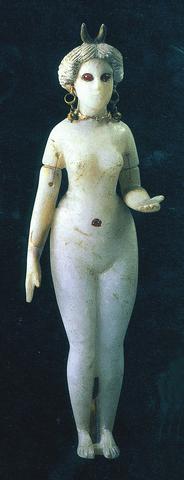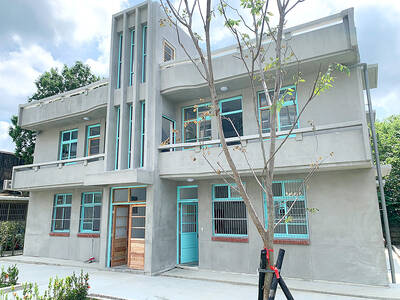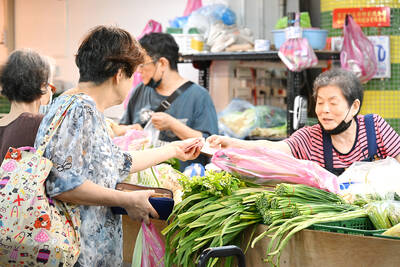When it's not a battle zone, the Middle East rarely figures on local people's radars. This might change, however, with an extensive exhibition in Taipei of Mesopotamian artifacts on loan from the Musee du Louvre in Paris.
Ancient Mesopotamia covered approximately the area of current day Iraq and was one of the earliest great civilizations, dating as far back as 8,000BC, and had a profound impact on the history of world culture. Mesopotamian civilization is a general term that includes Sumerian, Babylonian, and Assyrian cultures.

PHOTO COURTESY OF NATIONAL MUSEUM OF HISTORY
Mesopotamian societies made several breakthrough discoveries, including cuneiform writing, the wheel, a number system based on 10 and 60, and invented the earliest musical instrument and beer. The Biblical stories of the Garden of Eden and Noah's Ark were also set against the backdrop of Mesopotamian cultures.

PHOTO: COURTESY OF NATIOINAL MUSEUM OF HISTORY
The exhibition at the National Museum of History marks a divergence from the institution's usual emphasis on East Asian culture, as exemplified by the recent high-profile exhibition of the Qin Shihuang terra cotta warriors from China. With 299 items, the Mesopotamian show includes a variety of artifacts including sculptures, daily utensils and stoneware that cover the many societies that existed in that region through the millennia.
The objects on exhibit were found during the great wave of exploration by French archaeologists in the 1800s and early 1900s, as they searched -- some would say plundered -- the vast hinterlands between the Euphrates and Tigris rivers for historical treasures.

PHOTO: COURTESY OF NATIOINAL MUSEUM OF HISTORY
The selected works aim to cover the whole of Mesopotamian civilization with at least one major exhibit for each period. Coming from the Louvre, the objects have French titles with Chinese translations. For convenience, we provide an English translation as well.
The oldest piece on view is the Figurine d'une Femme nue (figurine of a naked woman, 裸婦小坐像), estimated to have been made between 6,000BC and 5,100BC. The pottery object is of a plump female figure symbolizing fertility and abundance. Another pottery piece is the beautiful Boisseau aux Bouquetins (vessel with rams, 羱羊杯) from 4,000BC.
Among the more majestic pieces is the Statue du Roi Pretre (statue of the priest king, 祭司國王像), dating from 3,300BC, and the Statuette d'un Homme (statuette of a man, 男人小像), from 2,500BC. These are the oldest complete sculptures ever found.
Taking center stage in this show is without a doubt the reproduction of the tablet on which is inscribed the Code of Hammurabi dating from between 1,792BC and 1,750BC. Written in the distinctive cuneiform writing, this historic royal decree mapped out the law governing Babylonian culture and is considered the world's first formal legal code.
Other highlights include colorful glazed murals like the Panneau de briques: Lion passant (brick panel: passing lion, 磚塊壁板:行走的獅子) from 6th-century BC Babylon and the Archer perse provenant de la frise des archers (Persian archer from the frieze of archers, 出自弓箭手橫列圖之玻波斯弓箭手), a life-sized glazed tile Persian archer from the rule of Darius between 522BC and 486BC.
The Rhyton termine en protome de bouquetin (vessel with ram horns, 以羱羊前半身為底部之角形飲器), a bronze ceremonial vessel for drinking from between 600BC and 400BC is in the shape of a goat head with large horns at the bottom and a wide open mouth at the top.
Of particular value is the Deesse Ishtar en Aphrodite (the goddess Ishtar as Aphrodite, 以阿茀洛黛娣出現的女神 希塔), a white plaster goddess decorated with rubies and gold. This piece combines the Mesopotamian tradition of mixing gold and colorful stones with the realistic style of Greek art. It is also speculated that the rubies may have been brought originally from Cambodia, evidence of Mesopotamian culture's trade with such distant places as East Asia.
Art Notes:
What: Aurora Of Human Civilization - The Mesopotamian Collection From The Louvre (美索不達米亞: 羅浮宮兩河流域珍藏展)
Where: National Museum of History (國立歷史博物館), 49 Nanhai Rd., Taipei (北市南海路49號)
When: Until July 15, Closed Monday
Tickets: NT$150

June 2 to June 8 Taiwan’s woodcutters believe that if they see even one speck of red in their cooked rice, no matter how small, an accident is going to happen. Peng Chin-tian (彭錦田) swears that this has proven to be true at every stop during his decades-long career in the logging industry. Along with mining, timber harvesting was once considered the most dangerous profession in Taiwan. Not only were mishaps common during all stages of processing, it was difficult to transport the injured to get medical treatment. Many died during the arduous journey. Peng recounts some of his accidents in

“Why does Taiwan identity decline?”a group of researchers lead by University of Nevada political scientist Austin Wang (王宏恩) asked in a recent paper. After all, it is not difficult to explain the rise in Taiwanese identity after the early 1990s. But no model predicted its decline during the 2016-2018 period, they say. After testing various alternative explanations, Wang et al argue that the fall-off in Taiwanese identity during that period is related to voter hedging based on the performance of the Democratic Progressive Party (DPP). Since the DPP is perceived as the guardian of Taiwan identity, when it performs well,

A short walk beneath the dense Amazon canopy, the forest abruptly opens up. Fallen logs are rotting, the trees grow sparser and the temperature rises in places sunlight hits the ground. This is what 24 years of severe drought looks like in the world’s largest rainforest. But this patch of degraded forest, about the size of a soccer field, is a scientific experiment. Launched in 2000 by Brazilian and British scientists, Esecaflor — short for “Forest Drought Study Project” in Portuguese — set out to simulate a future in which the changing climate could deplete the Amazon of rainfall. It is

What does the Taiwan People’s Party (TPP) in the Huang Kuo-chang (黃國昌) era stand for? What sets it apart from their allies, the Chinese Nationalist Party (KMT)? With some shifts in tone and emphasis, the KMT’s stances have not changed significantly since the late 2000s and the era of former president Ma Ying-jeou (馬英九). The Democratic Progressive Party’s (DPP) current platform formed in the mid-2010s under the guidance of Tsai Ing-wen (蔡英文), and current President William Lai (賴清德) campaigned on continuity. Though their ideological stances may be a bit stale, they have the advantage of being broadly understood by the voters.